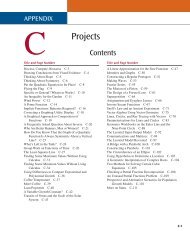HUsing ADO.NET 2.0 with Microsoft Access Databases - Cengage ...
HUsing ADO.NET 2.0 with Microsoft Access Databases - Cengage ...
HUsing ADO.NET 2.0 with Microsoft Access Databases - Cengage ...
Create successful ePaper yourself
Turn your PDF publications into a flip-book with our unique Google optimized e-Paper software.
Database Terminology 3<br />
Notice that each record in the table contains four fields: an ID field that indicates<br />
the department name and course number, a course title field, a number of<br />
credit hours field, and a grade field. In most tables, one of the fields uniquely<br />
identifies each record and is called the primary key. In the table shown in<br />
Figure H.1, you could use either the ID field or the Title field as the primary key,<br />
because the data in those fields will be unique for each record.<br />
To store information about your CD (compact disc) collection, you typically<br />
use a two-table database: one table to store the general information about each<br />
CD (such as the CD’s name and the artist’s name) and the other table to store the<br />
information about the songs on each CD (such as their title and track number).<br />
You then use a common field—for example, a CD number—to relate the records<br />
contained in both tables. Figure H.2 shows an example of a two-table database<br />
that stores CD information.<br />
Appendix H C5779 39147 Page 3 07/10/06--JHR<br />
The two tables are related by the<br />
Number field<br />
Number Name Artist<br />
01 Western Way Dolly Draton<br />
02 Midnight Blue Paul Elliot<br />
Number Song title Track<br />
01 Country 1<br />
01 Night on the Road 2<br />
01 Old Times 3<br />
02 Lovely Nights 1<br />
02 Colors 2<br />
02 Heavens 3<br />
FIGURE H.2<br />
Example of a two-table relational database<br />
The first table shown in Figure H.2 is often referred to as the parent table,<br />
and the second table is referred to as the child table. In the parent table, the<br />
Number field is the primary key, because it uniquely identifies each record in<br />
that table. In the child table, the Number field is used solely to link the song title<br />
and track information to the appropriate CD in the parent table. In the child<br />
table, the Number field is called the foreign key.<br />
Storing data in a relational database offers many advantages. The computer<br />
can retrieve data stored in a relational format both quickly and easily, and the<br />
data can be displayed in any order. For example, the information in the CD database<br />
shown in Figure H.2 can be arranged by artist name, song title, and so on. A<br />
relational database also allows you to control the amount of information you<br />
want to view at a time. You can view all of the information in the CD database,<br />
or you can view only the information pertaining to a certain artist, or only the<br />
names of the songs contained on a specific CD.
















